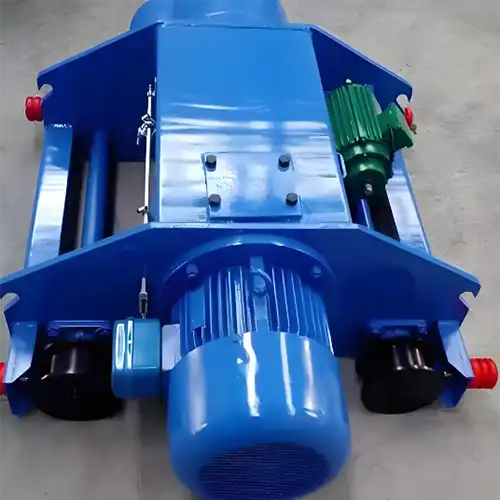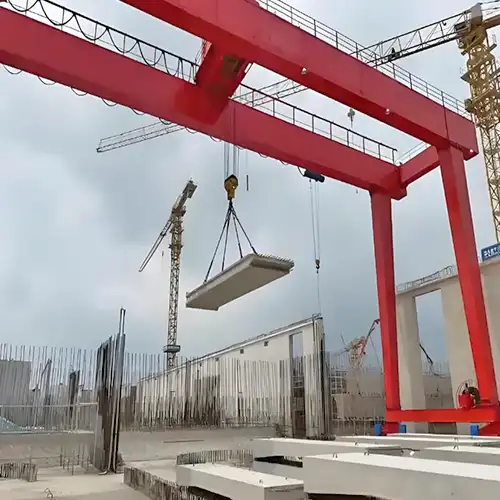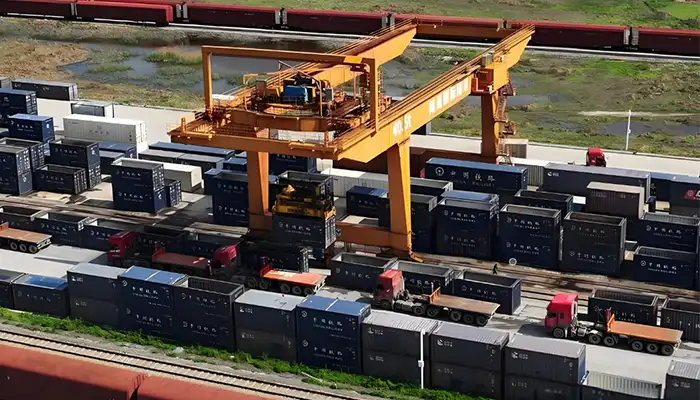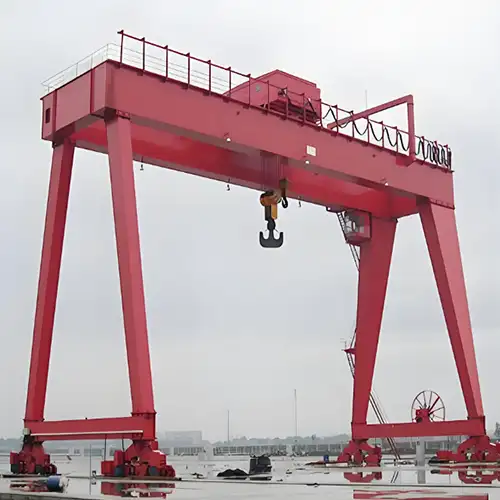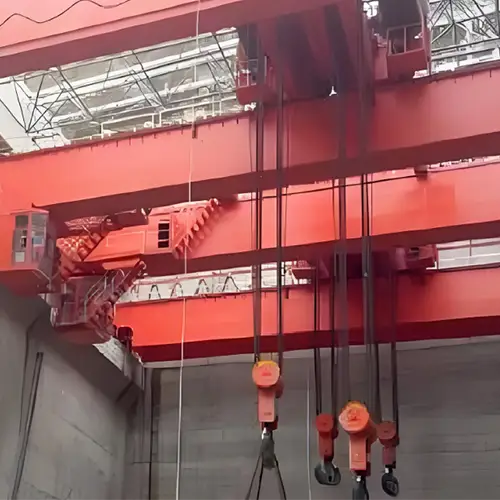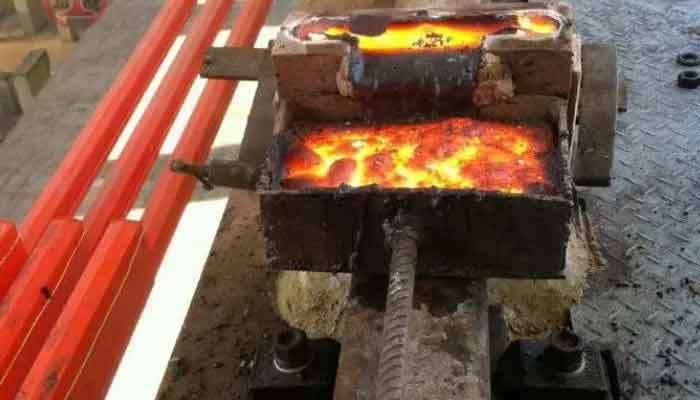
Crane Rail Welding: Why & How to Have Your Crane Rail Welded
Why to have your crane rail welded?
The advantages of continuously welded crane rails are significant in a steel mill or high-use material handling application. Crane rail is usually built in 20- or 30-foot lengths, with splices at the connections. Through expansion and contraction, these joints may develop gaps that, when the overhead travelling crane drives over them, put impact stress on the wheel, rail, and structures. With no expansion joint, these electric travelling crane rails can be welded into lengths of 300 meters or longer. Large rail cross sections and a high carbon and manganese concentration in the metallurgy make welding challenging.
Smoother overhead crane travel leads to longer rail life, less stress imparted to the crane runway structure, and longer life for the travelling crane wheels and drive components. Continuous welded rail also results in smoother crane travel. The cost of continuous welded crane rail and the requirement that the rails be joined on-site necessitate taking the runway segment out of operation while the work is being done. Cranes operating on continuous tracks experience a substantial amount of planned and unplanned maintenance requiring repair downtime due to the lower frequency of major maintenance issues. The reduction in downtime during the rail's lifespan must be taken into account when evaluating the process's financial sustainability.
Ways of crane welding : How to Get Get your crane rail welded
There are numerous welding techniques in use around the worldwide. Depending on the situation, the personnel, equipment, and consumables that are available, we will first recommend and then employ the most suitable way. The need to teach some local workers is sometimes a prerequisite for very large projects.
Challengs of crane rail welding
The rails that cranes run on should be welded into continuous lengths for optimal performance. Rails, on the other hand, are hard to weld due to their:
- High carbon content to give them wear resistance
- Be welded using special techniques and must have a hgih carbon equivalent
- Having A Big and Uneven Section for Welding.
Steel grades used to make crane and railroad rails are difficult to weld with traditional techniques. The most popular methods for on-site welding crane rails are enclosed arc (Puddle Arc).
Electric Arc Welding
Enclosed electric arc, also known as puddle arc welding, is one of the simplest methods to set up on a job site if you have a capable provider. The electric arc welding rail method is currently less widely used because the welding process and technical level are both high.Our skilled welders who can complete this task or training other workers to complete it. The two rail ends that need to be linked using this technique are squared off, spaced about 20 mm apart, heated up, and then welded using specialized manual metal arc electrodes.Manual metal arc equipment and special welding rods are used in Electric Arc. Sawing is used to cut the rail ends square. They are spaced apart by about 20 millimeters. The rails are cambered slightly to form a peak at the weld. This is then corrected by shrinkage of the liquid weld metal, which results in a flat top surface after welding. A copper strip is inserted beneath the weld metal.This removes any excess heat from the weld. A thin steel strip that serves as protection for it is incorporated into the weld in the end. Melted welding electrode is used to fill the gap between the rail ends. The rail's bottom flange is welded in a series of passes, with slag removed after each run. When this is finished, copper molds are placed on each side of the rail and a little away from the rail. In a continuous welding process, the gap is then filled with weld metal.The slag is allowed to run off the top of the molten metal through the small gap between the copper and the rail. The weld extends a few millimeters above the top surface of the rail. It should then be allowed to cool slowly with a heat insulating blanket. Grinding is then used to achieve the proper rail head profile.
Aluminothermic welding
Aluminothermic Welding utilizes a refractory mould around the ends of the two square cut rails. A crucible containing a charge of molten steel that has been chemically heated is used to fill a gap of about 20 mm left after preheating the rail ends.
Thermite welding
Thermite rail joining uses aluminum and iron oxide (along with additives) to join the rail through a thermal reaction at a specific temperature. The high-temperature liquid metal forms and is poured into a special mold, where the two welded rail ends are melted together to form the connection. Thermite welding rails have simple equipment, easy operation, low production costs, no upsetting process, good joint appearance, and a short lock-up time. Thermite welding railroad has low strength, poor quality, a high breakage rate, and poor overall performance. In seamless lines, the welding section of the thermite welding railroad is the weakest link.
Flash butt welding
It is sometimes used on the job site to weld crane rails. It necessitates thousands of amps of current and thus heavy, expensive equipment. The current passing between the rail ends heats them. When they are sufficiently heated, they are forged together.
The Flash-Butt Welding process was invented decades ago and has since become the standard method for joining rail all over the world. It is also the most expensive, as it necessitates specialized equipment and skills. This procedure must be carefully planned because there are only a few specialized suppliers with the necessary equipment.
Thermite welds are slower, cleaner, harder, and last longer than flash-butt welds. The rail's welded joint is a compact forged structure with good joint toughness, mechanical properties close to the steel base metal, and high production efficiency. It is primarily used for factory rail welding or base rail welding, with some unit steel rail welding as well. The flash butt rail welding machine is expensive, with a large one-time investment, complicated equipment, and the need for a high-power power supply and diesel generator set. The welding process parameters are more numerous, and the adjustment is time-consuming.
Rail Welding Procedure:How to do crane rail welding?
The length of each crane rail section varies from 6 to 25 meters depending on the type of crane rail. These crane rail sections must be welded together before being installed on the roadbed plane. So, what exactly is the crane rail welding procedure? In the rail welding process, what crane rail welding procedure is required? Let me explain it to you now.
Crane rail welding process
The crane rail welding, pre-weld preparation, stress relief heat treatment, and joint smoothing treatment are the four basic processes in the rail welding process.
The optimal conditions for the Rail welding processes are:
- Rails to be cut square. Not bevelled as with structurail wedling
- High preheat to accommodate the composition of steel.
- High deposition rates for welded metal.
- A tolerable defect level for the steel's fracture resistance.
These requirements are met by enclosed arc and aluminumothermic welding. For the majority of large section European railroads, flash butt is inappropriate. Both enclosed arc and aluminothermic technologies necessitate meticulous execution by trained workers.
Pre-weld preparation
To make the welding process easier, the end face of the crane rails should be thoroughly cleaned to remove oil, rust, or other debris before welding the connection. Materials like welding rods and equipment should be prepared in accordance with the crane rail welding technique being used.
The end of the crane rail must be cushioned up to a particular height in preparation to make welding easier. The specifics of the crane rail, such as the sizes and materials, determine the actual cushioning height.

Crane rail welding
Crane rail welding should be conducted in the order of rail bottom, rail waist, rail head. Layer after layer of welding must be completed before the surrounding gap is repaired. Preheating and interlayer temperature control between 300 and 350 degrees, simultaneously at both ends of the track. The recommended current range for welding rail bottoms is 120A–130A. The slag needs to be clear after each layer of welding is finished for welding to proceed. Rail waist welding now ranges from 130 to 140 amps, welding upward from the lower waist while paying close attention to slag removal. The weld around the weld point is eventually repaired during the welding of the rail head, which continues to employ current values of 130A to 140A.
Stress relief heat treatment
An important step to enhance the quality of the crane rail welding is the stress relief heat treatment on the ends of the crane rail sections. In order to evenly heat the whole section of the rail during the stress relief heat treatment, a gas welding nozzle is used to repeatedly heat the rail's head, waist, and bottom. The temperature for the stress relief heat treatment should be between 620 and 650 degrees, and it should remain there for 20 to 30 minutes. The range of stress relief heat treatment extends every 40MM from the crane rail welding point.
The smoothing treatment for the joint of crane rail
The weld on the top and sides of the rail must be smoothed after the stress relief heat treatment and air temperature cooling of the rail welded junction. When the welding bulge on the crane rail is too large, use a grinding wheel polishing machine to reduce it until the welding spot is flat with the rail head. Then, polish the surface.
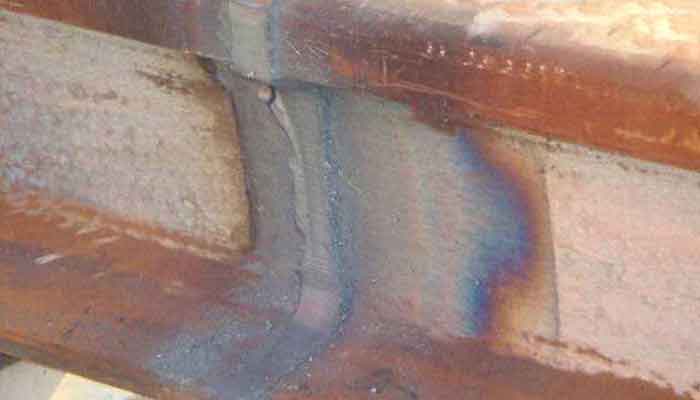
Crane rail welding and installation
We have provided teams of trained and qualified personnel to complete installations in a variety of countries and settings. There is a lot of leeway, and operations can be carried out to meet tight project deadlines or to refurbish key plant during short outages. Before work begins, careful planning is required, including early site visits and team formation. Materials and equipment, as well as appropriate protection for the site conditions, must be available on-site. Welding consumables can degrade in the environment and some pose hazards. We have frequently risen to challenges.

Related reading: Crane Rail & Track Overview: Types, Specifications & Selections
